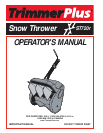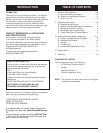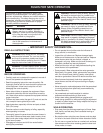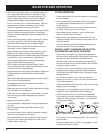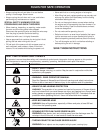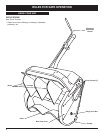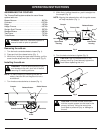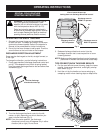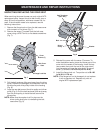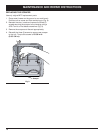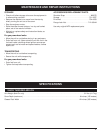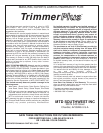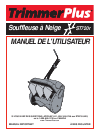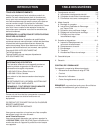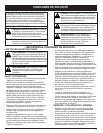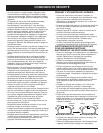
RULES FOR SAFE OPERATION
4
• After striking a foreign object, turn the powerhead off
and inspect the snow thrower for damage. For gas
powerheads: Remove wire from the spark plug. For
electric powerheads: Disconnect the cord. Repair
damage before restarting and operating the unit.
• If the unit should start to vibrate abnormally, stop the
powerhead and check immediately for the cause.
Vibration is generally a warning of trouble.
• Stop the powerhead whenever you leave the operating
position, before unclogging the rotor or discharge
vanes, and when making any repairs, adjustments, or
inspections.
• Clear snow from slopes by going up and down. Never
go across the slope. Use caution when changing
directions. Never clear snow from steep slopes.
• Never attempt to use the snow thrower on a roof or
any steep, inclined, slippery surfaces.
• Never operate snow thrower without proper guards,
plates or other safety protective devices in place.
• Never operate the snow thrower near glass enclosures,
automobiles, trucks, window wells, dropoffs, etc.
without proper adjustment of the snow discharge
angle. Keep children and pets away.
• Don’t force or overload the snow thrower. Snow
thrower will perform at its best and safest when run at
the rate for which it was designed.
• Never operate the machine at high transport speeds on
slippery surfaces. Look behind and use care when
backing.
• Never direct discharge towards people or allow anyone in
front of the unit while operating.
•Disengage power to the rotor when snow thrower is
transported or not in use.
•Make sure the rotor will spin freely before attaching the
snow thrower to the powerhead.
• If the rotor will not rotate freely due to frozen ice, thaw
the unit thoroughly before attempting to operate it
under power.
•Keep the rotor clear of debris.
• Do not overreach. Keep proper footing and balance at
all times.
• Never discharge snow onto public roads or near
moving traffic.
• Let snow thrower run for a few minutes after clearing
snow so moving parts do not freeze.
• Never operate without good visibility or light. Always
be sure of your footing and keep a firm hold on the
handles. Walk; never run.
AFTER OPERATING:
• Follow instructions for care, maintenance, and storage
of snow thrower.
• Only qualified personnel should perform any repairs
or maintenance procedures that are not described
in this manual.
• Remove residue ice or snow from the vanes and rotor
by briefly running the unit out of snow.
• Store snow thrower indoors in a dry, locked place.
Keep out of the reach of children.
• Always refer to the operator's guide instructions for
important details if snow thrower is to be stored for an
extended period.
• Use only attachments and accessories approved by
the manufacturer of the snow thrower.
SPECIAL SAFETY WARNINGS FOR ELECTRIC
POWERHEADS AND SNOW THROWERS
•When cleaning, inspecting, or repairing, make certain
the rotor and all moving parts have stopped. Disconnect
the extension cord to prevent accidental starting.
• Use extension cords and receptacles as specified by
the manufacturer for all units with electric drive motors
or electric starting motors.
• Use only 3-wire outdoor extension cords that have 3-
prong grounding-type plugs and 3-pole receptacles
that accept the snow thrower's plug. Replace or repair
damaged cords.
• Do not abuse extension cord. Never carry snow
thrower by the cord or yank on the cord to disconnect
it from the receptacle.
• Keep the extension cord away from heat, oil, and sharp
edges to prevent damage.
• If extension cord is damaged in any manner while
plugged in, pull extension cord from receptacle.
• Prevent disconnection of snow thrower powerhead
from extension cord during operation by using a plug-
receptacle retaining strap, connector, or by making a
knot as shown below:
• Do not use in rain or during a snowfall. Do not use in or
around water.
• Avoid accidental starting. Don't carry plugged-in snow
thrower with finger on switch.
Extension
Cord
Snow
Thrower Cord
Snow
Thrower Cord
Extension
Cord



